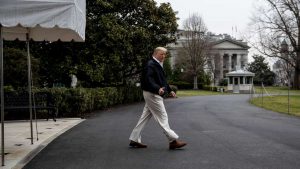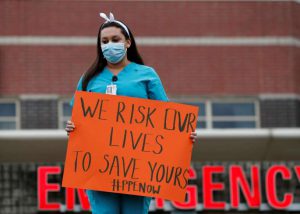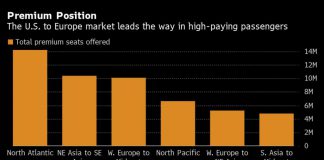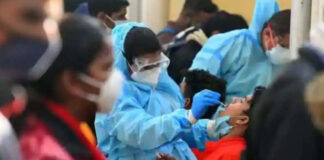MARCH 28, 2020

President Trump leaving the White House this month to travel to Nashville. – Anna Moneymaker/NY Times
WASHINGTON, D.C. — President Trump said Saturday night that he would not impose a quarantine on New York, New Jersey and Connecticut to prevent the spread of the coronavirus, but would instead issue a “strong” travel advisory for the region to be enacted by the governors of the three states.
Mr. Trump made the announcement on Twitter just hours after telling reporters that he was considering a quarantine of the area in an effort to limit the spread of the virus to Florida and other parts of the country, a move that would have been a drastic exercise of federal power to further restrict travel by millions of Americans.
Mr. Trump had offered no details about how his administration would enforce a ban on movements in and out of the three northeastern states, including the country’s most populous city, and the idea drew swift condemnation. Gov. Andrew M. Cuomo of New York called it a “declaration of war on states,” and Gov. Ned Lamont of Connecticut said it could cause confusion and panic.
The president appeared to heed those warnings, abruptly abandoning a proposal that he had floated with no notice on Saturday morning, once again subjecting the country — and, in particular, people in the northeast — to mixed messages about what his administration believed was necessary to defeat the dangerous pathogen.
Public health experts warned that even flirting with the idea of a travel ban for one of the most populated parts of the country was likely to backfire, causing residents to flee for fear of being stuck — only to potentially take the virus with them.
In his tweet, Mr. Trump said that he had consulted with the governors and had decided that a quarantine would not be necessary after all.
Later Saturday night, the Centers for Disease Control and Prevention issued a formal advisory urging the residents of the three states to “refrain from nonessential domestic travel for 14 days effective immediately.” The advisory, which was posted to the agency’s website and its Twitter account, does not apply to “employees of critical infrastructure industries,” the agency said. That includes trucking, public health professionals, financial services and food supply workers.
The specter of a federal quarantine came after a wave of governors, fearful about the virus spreading further through their states, had ordered people who had traveled from New York to isolate themselves for two weeks after their arrival. Gov. Gina Raimondo of Rhode Island said Friday that state troopers would begin stopping drivers with New York license plates so that National Guard officials could collect contact information, and informed anyone coming from the state that they were subject to a mandatory, 14-day quarantine.
Earlier in the day, Mr. Trump had implied that a quarantine might be necessary to achieve that same goal, though he was quick to insist that such a move would not prevent truckers from making deliveries from outside the area and would not affect trade with the three states “in any way.”
Speaking to reporters before traveling to Norfolk, Va., to see off the Navy’s Comfort ship as it deployed to New York to bolster hospital capacity, Mr. Trump said that New York and the other states had become a “hot spot” and that infected residents had been carrying the pathogen to Florida.
“There is a possibility that sometime today we’ll do a quarantine, short term, two weeks, on New York, probably New Jersey, certain parts of Connecticut,” Mr. Trump, a former New Yorker who now is officially a Florida resident, said on Saturday morning. “They’re having problems down in Florida. A lot of New Yorkers going down, we don’t want that, heavily infected.”
The president’s musing about a quarantine — and his subsequent decision to back away from the idea — was the latest example of how he has lurched from one public message to another as his administration struggles to slow the spread of a deadly pandemic, prevent large-scale deaths and minimize the long-term damage to the nation’s economy and the American way of life.
Days earlier, Mr. Trump had repeatedly defied the recommendations of his own public health experts by insisting that he wanted to lift social distancing restrictions so that large parts of the country could return to work, perhaps as early as April 12. But on Saturday, the president veered in the other direction, suggesting that even more stringent restrictions, like a quarantine, might be necessary to slow the spread of the virus.
“I’d rather not do it, but we may need it,” Mr. Trump said of a quarantine before swerving back in the other direction about seven hours later.
The flip-flop from Mr. Trump came as the White House’s two-week national coronavirus guidelines — including recommendations to work from home, avoid discretionary travel and limit gatherings to no more than 10 people — are set to expire on Monday. Mr. Trump has not yet said whether he will extend them.

(Pictured) A nurse demonstrates outside the emergency entrance at Jacobi Medical Center on March 28 in New York, demanding more personal protective equipment for medical staff.
The suggestion from the president that he might prevent residents of the tristate region from leaving their states surprised top officials.
Mr. Cuomo quickly dismissed the idea, calling it “unworkable” and questioned whether the president had the authority to confine vast numbers of Americans in a particular area.
“I don’t even know what that means,” Mr. Cuomo said during an afternoon briefing in Albany. Asked about the proposal on CNN, Mr. Cuomo said the plan stood at odds with the president’s desire to restart the economy. “You would paralyze the financial sector,” he said, adding that the stock market would “drop like a stone.”
Mr. Cuomo said that he and the president had spoken earlier on Saturday, but added, “I didn’t speak to him about any quarantine.” Gov. Philip D. Murphy of New Jersey also said that he was unfamiliar with what Mr. Trump had suggested. Mr. Lamont said in a statement that he looked forward to discussing the proposal with Mr. Trump “because confusion leads to panic.”
Mr. Trump did not give any reasons for his change of heart, but legal experts had also raised doubts about whether a federal quarantine of such a large region based on public health concerns would be constitutional.
White House officials had provided no specific information about the legal basis for a mass quarantine of millions of people and Mark Meadows, the president’s incoming chief of staff, said only that the administration was “evaluating all the options right now.” But pressed on the matter, officials referred reporters to a Centers for Disease Control and Prevention website titled “Legal Authorities for Isolation and Quarantine.”
The site asserts that the commerce clause of the Constitution gives the federal government the power to isolate or quarantine people, and that section 361 of the Public Health Service Act authorizes the secretary of health and human services to “take measures to prevent the entry and spread of communicable diseases from foreign countries into the United States and between states.”
But Leila Barraza, an assistant professor of public health at the University of Arizona, said an attempt by the federal government to restrict travel between states was likely to be challenged in court, especially if the president had not tried less draconian measures first.
“There has to be a compelling interest for imposing interstate travel restrictions, and they have to be the least restrictive possible,” she said.
The purpose of a quarantine would have been to prevent the spread of a deadly pathogen. But medical experts were split on Saturday about whether such an action would help. As of Saturday, the United States had more than 120,000 known cases of the virus, with infected patients in all 50 states and Washington, D.C.
Other countries, including India, have embraced severe lockdowns of their citizens, including limits on travel, in an effort to try to prevent the spread of the virus, something that some public health experts say can still be effective in the United States.
But Dr. Amesh Adalja, an assistant professor at Johns Hopkins Bloomberg School of Public Health, countered that Mr. Trump’s comments on a possible quarantine would provide little benefit, given that much of the region was already under fairly strict stay-at-home measures.
“Just seeing the breaking news alerts on their phones will cause people to leave the city,” Dr. Adalja said. “It could end up creating more flight from New York and more chains of transmission.”
That is what happened in China after the mayor of Wuhan, where the virus first emerged, began speculating about the possibility of closing his city to keep the virus from spreading.
Panicked residents — many of whom were already planning to leave for the Lunar New Year holiday — fled the city. Five million people escaped before air, train, bus and road traffic was finally firmly shut on Jan. 23. Their travel to other parts of the country seeded new outbreaks all over China.
Public health officials around the country have criticized Mr. Trump and his administration for failing to move quickly enough to provide diagnostic testing that may have helped track the spread of the virus earlier. Governors and mayors have pleaded with the president to do more to help them acquire protective gear like masks and ventilators for emergency medical workers, nurses and doctors.
Mr. Trump raised the prospect of a quarantine even as he left the White House for the first time in more than a week to travel to a naval base in Norfolk so that he could trumpet the departure of the Comfort, a 894-foot naval hospital ship, for New York City. Its 1,000 beds would play a “critical role” in freeing up capacity at area hospitals, he said.
“You have the unwavering support of the entire nation, the entire government and the entire American people,” Mr. Trump said.
Courtesy/Source: NY Times










































































































